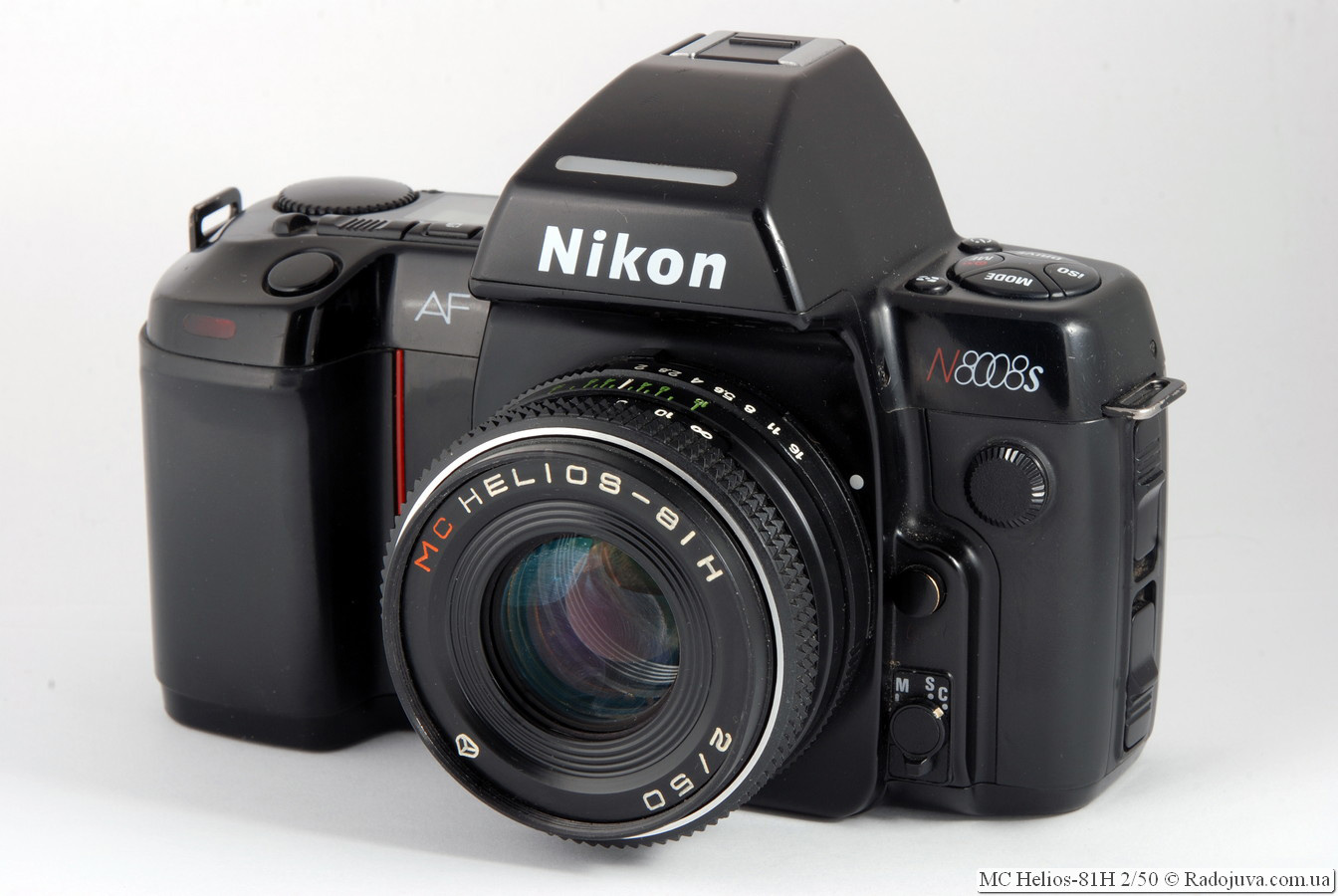
MC Helios-81H 2/50 lens on the camera Nikon AF N8008s. Enlarge Image.
In short
MC Helios-81H 2/50 (or MC Helios-81H 2/50, or Arsat H 50mm 1: 2) - is one of the best standard lenses of Helios family... This lens is most often called a 'fifty-kopeck piece' because of the focal length of 50mm. On full-frame cameras (film and digital cameras with a frame size of 36 x 24 mm) it is standard (in terms of focal lengths and angle of view) and is suitable for everyday use for a wide range of tasks. Helios-81 can also be used as a portrait and creative lens on modern cropped cameras.
In my opinion, Helios-81 earned its popularity due to its compatibility with Nikon digital SLR cameras with Nikon F mount. The bulk of the lenses of the Helios-81 family do not require any adapters and work similarly to the original manual Nikon Nikkor AI / PRE-AI lenses. ...
Also, the popularity of the lens is associated with a special twist of the background, inherent in many lenses of the Helios family, as well as good optical capabilities at a fairly low cost. On average, Helios-81N can be found for $ 30.
Critical: there are many different versions of the Helios-81 H/M/AUTOMATIC family of lenses. If the latest versions are indeed some of the best standard lenses from Helios family, then early versions are the worst... Early versions are easily distinguished by their wide focusing ring and serial number near the front lens. These options have many mechanical problems. Later and better versions have a serial number in small print on the side of the aperture control ring. Here is such a paradox - from the best to the worst is just a step. I strongly advise against messing with these early versions (shown, for example, in the 'Appearance # 3' section). And also by no means do not purchase lenses marked 'AUTOMATIC'... Lenses series Helios-81N AUTOMATIC have a different mount, for which there are no adapters for any cameras (the appearance of lenses HELIOS-81 2/50/53 AUTOMATIC shown here). If something is not very clear, or if you want to be 100% sure that the future purchased lens will please you - ask here in the comments, or contact me according to my personal contacts.
It is difficult to overestimate the creative potential of such fifty dollars. Photo enthusiasts often use it as a portrait lens. Many people just want a fast prime, especially in addition to their stock / kit lens. Aperture F / 2 approx. three steps wider aperture of f / 5.6, which is used in 'dark' kit lenses at the long end. In numerical terms, this means that Helios-81 is approximately 8 times brighterthan, for example, whale Nikon DX VR AF-P Nikkor 18-55mm 1: 3.5-5.6Gwhich use a maximum relative aperture of only 50: 1 over a 5.6 mm focal length. The calculation of the difference in the relative aperture (count the aperture) is performed elementarily: (5.6 * 5.6) / (2 * 2) = 7.84, which is rounded to the value '8'.
History
Helios-81 is a descendant of the Helios-65 (HELIOS 65 AUTOMATIC 2/50), which, in turn, is a shortened descendant of the lenses family Helios-44.
The Helios-81 lens family includes many models and their modifications. In general, the development of the line proceeded as follows: Helios-81 AUTOMAT -> Helios-81 M or N -> MC Helios-81 M or N -> MC Helios-81 N -> Arsat H. Each of the modifications has several subversions.
For practical use, the latest versions of MC Helios-81 H (aka 'MC HELIOS 81 H') and Arsat are best suited for which the serial number is indicated in small print on the lens barrel, and not near the front lens.
Appearance # 1
Lens shown below MS HELIOS-81H 2/50 with serial number 9227112, presumably produced in 1992. The front and rear lenses of the objective have cyan, blue, lilac, violet and red anti-reflective shades.
Appearance # 2
Lens shown below MC HELIOS-81H 2/50 with serial number 9315003, presumably produced in 1993. The front lens of the objective has green, purple and red shades of enlightenment.
Appearance # 3
Lens shown below MS HELIOS-81M 2/53 with serial number 8204223, presumably produced in 1982. Filter diameter 49 mm. The front lens of the objective has blue, lilac, violet, red and yellow anti-reflective shades. The petals of the diaphragm are shiny, yellowish-orange (copper-colored). The focus ring rotates 315 degrees (7/8 of a full turn). Three intermediate clicks between F / 2 and F / 2.8 and two intermediate clicks between the other pairs of f-numbers (rare). Does not sit on without alteration Nikon D70, D70s, D80, D90... Nikon is installed on the rest of the CZK without problems. No protrusion for the diaphragm rheostat, with a long 'skirt' of the diaphragm control ring (but the skirt does not rest against the diaphragm rheostat). Nikon F mount, letter 'M' stands for 'M' blinking aperture.
Appearance # 4
Lens shown below ARSAT H 50mm 1: 2 with serial number 9417121, presumably produced in 1994. The front lens of the objective has green, purple and blue shades of enlightenment.
Appearance # 5
Lens shown below HELIOS-81N 2/53 with serial number 8309805, presumably produced in 1983. Filter diameter 49 mm. The front lens of the objective has bluish and ash shades of enlightenment. The diaphragm blades are shiny, silvery. The focus ring rotates 315 degrees (7/8 of a full turn). Three intermediate clicks between F / 2 and F / 2.8 and two intermediate clicks between the other pairs of f-numbers (rare). Does not sit on without alteration Nikon D70, D70s, D80, D90... Nikon is installed on the rest of the CZK without problems. No protrusion for the diaphragm rheostat, with a long 'skirt' of the diaphragm control ring (but the skirt does not rest against the diaphragm rheostat). Nikon F. mount.
Main technical specifications MC Helios-81H 2/50
| The name of the instance from the review (as it is written on the lens itself) | MC Helios-81H 2/50 with the logo of the Arsenal factory (there are a lot of other ways to write the name of the lens) |
| Basic properties |
|
| Front Filter Diameter | 52 mm (there are options for 49 mm) |
| Focal length | 50 mm (according to some sources - 52 or 53 mm), EGF for cameras with an APS-C type sensor is approximately 75 mm |
| Zoom ratio | 1 x |
| Designed by | for film cameras with a frame size of 36 mm X 24 mm |
| Number of aperture blades | 6 petals. Petals form a hexagon of approximately the correct shape. Petals are dull metal, not blackened. |
| Tags |
|
| Diaphragm | From F / 2 to F / 16.0, it is regulated by the aperture ring, there is no diaphragm operation method switch on the lens. The ring has one intermediate fixed value between the indicated pairs of numbers (between F / 11 and F / 16 there is no intermediate value). |
| MDF (minimum focusing distance) | 0.5 m, maximum magnification ratio is 1: 7 (approximately) |
| The weight | 214 grams measured without caps (lens itself only) |
| Optical design | 6 elements in 4 groups, ('Planar' type scheme) |
| Lens hood | screwed into the front filter, the original lens hood markings were not found. Any analogs are suitable, according to type of such |
| Manufacturer country | USSR, Arsenal plant (later the lens was produced under the 'Arsat' brand in Ukraine). |
| Period | Several years, the exact period of production is unknown. |
Lens modifications
Please note that there are many modifications of the lens and many spellings of its name. The main ones are:
'AUTOMATIC' versions
- Helios-81 2/50 Automatic - you can see an overview of this modification here
- Helios-81 2/53 Automatic - you can see an overview of this modification here
- Helios 81 2/50 Automatic (no dash between 'Helios' and '81')
Versions 'М 2/53'
- Helios-81М 2/53 with H-mount, metal silvery unblacked petals, you can see an overview of this modification here
- Helios-81М 2/53 H-mount, copper colored metal petals not blackened
- MS Helios-81M 2 /53 H-mount, copper-colored, unblacked metal petals (appearance # 3 from this review)
Versions 'H'
- MS Helios-81H 2/50 (with serial number near the front lens, long skirt of the aperture control ring, wide focusing ring)
- MS Helios-81N 2/50 (serial number from the bayonet side, short skirt of the diaphragm control ring, lilac enlightenment, one of the most common and classic options)
- MS Helios-81N 2/50 (serial number from the bayonet side, short skirt of the diaphragm control ring, green enlightenment, one of the most common and classic options)
- MS Helios-81N 2 /53 (appearance # 5 from this review)
- Helios-81Н 2/53 (analogue of Helios-81M 2/53)
- ARSAT H 1: 2 50mm - an almost complete copy of MC Helios-81N 2/50, the differences are described here
- MC Helios-81h 2/50 - full copy of MS Helios-81H 2/50, export version, this version looks like like this.
- MC Helios-81 2/50 - full copy of MC Helios-81N 2/50, export version
Other versions
- Helios-81 2/50
- Helios-81 2/52 (diaphragm ring on the front of the lens)
- Helios-81 (GK-81)
- GOI << HELIOS-81 >> 2 / 52,4 (silver metal case)
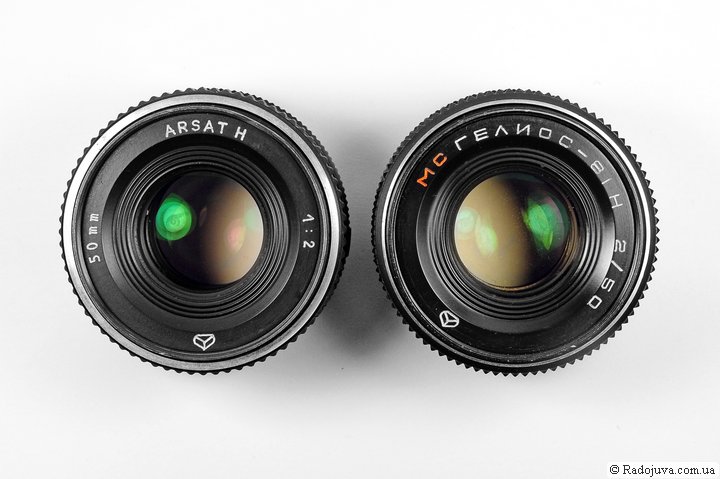
Just different names: ARSAT 1: 2 50mm МС ГЕЛИОС-81Н 2/50
Optically, they are the same lens. The difference between lenses with different names lies in different mounting threads or mounts, body rims, enlightenment and age. Many new lenses MS Helios-81Nreleased in Ukraine (after the collapse of the Union) are called Arsat. This review discusses one of the most popular lenses, namely MS Helios-81H 2/50.
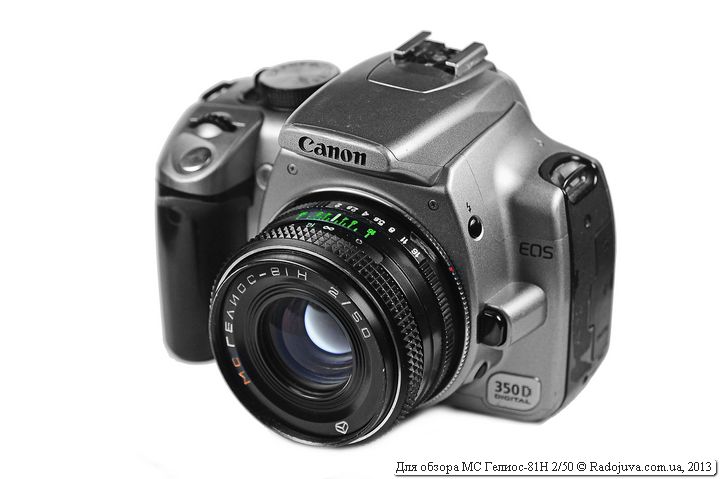
View of the Helios-81N MS lens on a Canon EOS camera 350D Digital The lens is mounted using a cheap adapter Nikon mount F - Canon EOS.
As usual, the first thing you feel and pay attention when using the old lens is its weight, the lens is small, very short, it resembles a pancake. The weight of this “pancake” is quite large. The build quality is usual - a lot of metal and glass. The lens has no backlash.
Interesting: 81-H is read not as 81-'ash ', but as 81-'en'. Easy to remember 81-Nikon, as 'H' mount is Nikon F mount (Nikon F mount)
MS Helios 81-N produced at the Arsenal plants in Kiev or Uman in Ukraine. The lens used special lanthanum glasses - super-heavy crowns with high resolution, this allows you to partially get rid of chromatic aberrations.
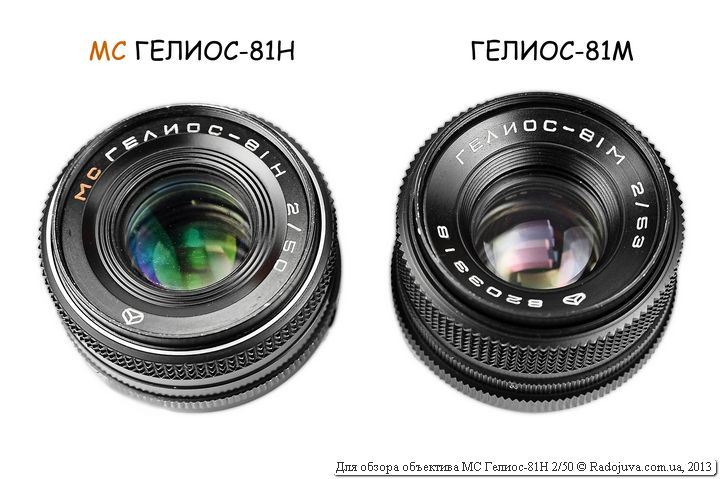
So there are two versions of the Helios 81 lens
How to use with modern cameras
Nikon F-mount DSLRs
To use the Nikon MS Helios-81H 2/50 lens on Nikon DSLR cameras just install the lens without any adapters and shoot for your own pleasure without any tangible limitations. Possibility focusing on infinity, as well as semi-automatic iris control... This is due to the fact that MC Helios-81H 2/50 uses the same bayonet mount (mount type) as the native Nikon lenses. All lenses from cameras Kiev-17, Kiev-17m, Kiev-18, Kiev-19 and Kiev-19m, Kiev-20 use the Nikon F mount, the same as that of modern Nikon DSLRs. Some cameras will even have automatic metering exposure. Exact list of cameras that support metering exposure with manual lenses (such as this one) you can see here or here. For more information on how to use manual lenses, see my article. Soviet optics.
Important: although the lenses MC Helios-81N 2/50 have a protrusion for transmitting the aperture value to the camera through the aperture rheostat (copy AI Nikkor Lenses), while the diaphragm skirt may be too long (like PRE-AI Nikkor Lenses) because some Lenses Helios-81 2/50 without additional modification cannot be installed on modern Nikon DSLR cameras. Some can only be installed on a specific list of cameras. To treat such a disease can be very simple - just cut off part of the diaphragm control ring, as shown in the figure by Sergei Elizarov here.
It's important: if you come across a lens that does not sit on your camera and you don’t want to cut it, you can still easily use the lens on any Nikon DSLR with macro rings... MC Helios-81N 2/50 can be easily installed on any Nikon F cameras via Any extension tube for Nikon F-mount cameras... However, this loses the ability to focus to infinity and medium focusing distances.
Important: to immediately find a variant of MC Helios-81H 2/50, which can work on any Nikon F-mount SLR camera, you need to look for lens options with the name MC Helios-81H 2/50 (or MC HELIOS-81H 2/50) and without a serial numbers near the front lens, as well as any lens variants with the modern name ARSAT.
Important: if something is not clear, or there is a desire to clarify - write in the comments under this review, I and other readers will try to suggest.
Nikon 1 mirrorless cameras
To use the lens on a series of mirrorless cameras Nikon 1 (Nikon 1S1, Nikon 1S2, Nikon 1 V1, Nikon 1 V2, Nikon 1 V3, Nikon 1 J1, Nikon 1 J2, Nikon 1 J3, Nikon 1 J4, Nikon 1 J5, Nikon 1 AW1) use the adapter Nikon F - Nikon 1. The cheapest adapters can be found aliexpress.com. For example, such an adapter can be easily purchased. here.
Important: there are no problems with any versions of Helios-81 for Nikon F mount (Nikon 'N') and any corresponding adapters.
Nikon Z mirrorless cameras
To use the lens on a series of mirrorless cameras Nikon Z use an original Nikon FTZ adapter.
You can use any inexpensive Chinese analogue, for example, such an adapter Nikon AI -> Nikon Z.
Important: there are no problems with any versions of Helios-81 for Nikon F mount (Nikon 'N') and any corresponding adapters.
Canon (EF, M, RF)
In order to install MC Helios-81N 2/50 on any modern digital SLR camera Canon EOS, you will need to use the adapter Nikon mount F - Canon EOS. Possibility focusing on infinity saved. The cheapest adapters can be found aliexpress.com. For example, adapter Nikon mount F - Canon EOS EF (aka Nikon AF-> Canon EF) easy to buy here.
It's important: all lenses of the Helios-81H family (with 'H' / 'Nikon F' mount), regardless of the year of manufacture and the features of the mount, can be installed on any camera without any problems Canon EOS using the specified adapter Nikon mount F - Canon EOS EF (aka Nikon AI-> Canon EF).
To use the lens on mirrorless cameras series Canon EOS M use adapter Nikon F - Canon EOS M (aka Nikon AI-Canon M). The cheapest adapters can be found aliexpress.com. For example, such an adapter can be easily purchased. here.
To use the lens on mirrorless cameras Canon EOS R series, use an adapter Nikon F - Canon EOS R (aka Nikon AI-> Canon RF). The cheapest adapters can be found aliexpress.com. For example, such an adapter can be easily purchased. here.
Sony (A, E)
Using the lens with SLR cameras Sony (DSLRs as well as SLT cameras with a translucent mirror) is difficult. For use, an adapter with a corrective lens should be used, which may negatively affect the image quality. If you still want to use MC Helios-81N 2/50 on cameras Sony / Minolta with A-mount, use the adapter Nikon F - Sony A. The cheapest adapters can be found aliexpress.com. For example, such an adapter can be easily purchased. here.
To use the lens on mirrorless cameras Sony NEX, Sony ILCE, Sony ALPHA with Sony E mount or Sony FEjust use an inexpensive adapter Nikon F - Sony E. The cheapest adapters can be found aliexpress.com. For example, such an adapter can be easily purchased. here... Also available for these cameras autofocus adapter Techart PRO Leica M - Sony E Autofocus Adapterwhich can be found at this link.
FUJIFILM (X, GFX)
X-mount mirrorless cameras require an adapter Nikon F -> Fuji X (aka AI-> X). The cheapest adapters can be found aliexpress.com. For example, such an adapter can be easily purchased. here.
For mirrorless medium format cameras with mount GFX need adapter Nikon F -> Fuji GFX (aka AI-> GFX). The cheapest adapters can be found aliexpress.com. For example, such an adapter can be easily purchased. here.
SIGMA / PANASONIC / LEICA (L, M)
An adapter is required for mirrorless cameras with Leica L mount (T, TL, SL) Nikon F -> Leica L (aka AI-> L). The cheapest adapters can be found aliexpress.com. For example, such an adapter can be easily purchased. here. For cameras with a Leica M mount need adapter Nikon F -> Leica M (aka AI-> M).
PENTAX
Using a lens with Pentax SLR cameras is difficult. For use, an adapter with a correction lens should be used, which can adversely affect image quality. If you still want to use Helios-81H 2/50 MC on Pentax cameras with K mount (and its modifications), then you should use the adapter Nikon F - Pentax K. The cheapest adapters can be found aliexpress.com. For example, such an adapter can be easily purchased. here... The same goes for a mirrorless camera. Pentax K-01.
To use the lens on Pentax mirrorless cameras with Pentax Q mount (Pentax Q, Pentax Q10, Pentax Q7, Pentax Q-s1)just use an inexpensive adapter Nikon F - Pentax Q. The cheapest adapters can be found aliexpress.com. For example, such an adapter can be easily purchased. here.
Samsung (NX)
NX mount mirrorless cameras require an adapter Nikon F -> Samsung NX (aka AI-> NX). The cheapest adapters can be found aliexpress.com. For example, such an adapter can be easily purchased. here. For the camera Nx mini adapters do not exist yet.
OLYMPUS / PANASONIC / KODAK / XIAOMI (mirrorless, MICRO 4/3)
To use the lens on mirrorless cameras OLYMPUS/PANASONIC/KODAK/ XIAOMI (and some others) with a Micro 4/3 mount, it is enough to use an inexpensive adapter Nikon F - MICRO 4/3. The cheapest adapters can be found aliexpress.com. For example, such an adapter can be easily purchased. here.
OLYMPUS / PANASONIC / LEICA (mirrors, 4/3)
For SLR cameras with a 4/3 mount (not to be confused with Micro 4/3!) An adapter is required Nikon F-> 4/3. The cheapest adapters can be found aliexpress.com. For example, such an adapter can be easily purchased. here.
Attention! Lenses of the HELIOS AUTOMAT series
Very important: the lenses Helios-81 2/50 AUTOMATIC и Helios-81 2/53 AUTOMATIC cannot be used with modern cameras. Simply there are no corresponding adapters. Attackers often give out Helios-81 2/50 Automatic (a review of this modification you can see here) и Helios-81 2/53 Automatic (a review of this modification you can see here) for the lens MC Helios-81N 2/50. Be attentive!
Sample photos on Nikon DX (APS-C, crop 1.5X)
Below are my photos for different modifications of the Helios-81 / Arsat H lens:
Jpeg source photos watch and / or download here (200+ photos on Nikon D40).
Sample photos on MC Helios-81H and Nikon FX (full frame, Full Frame)
All photos were taken on a Helios-81N MC and a full-frame camera Nikon D700 FX no processing. Reduced size to 1920 * 1080 pixels and imprinted data from EXIF.
UPDATED
Photographer shared examples of photos on MC Helios-81N 2/50 with readers of Radozhiva Lilia Nemykina:
My experience
I like Helios-81N, with it you can feel the spirit of Soviet lenses, get nice shots and feel like a real manual technician (a photographer who uses manual lenses).
Unfortunately, I must state the fact that in general this fifty kopeck piece loses in many respects to any autofocus similar lens. Helios-81N is very popular, but still, if possible, I recommend using autofocus fifty dollars. Some of them, for example, Nikon 50 / 1.8 AF MKI / II / III (D) (for cameras with a focus motor) or Yongnuo 50 / 1.8 (for any Nikon cameras) are only slightly more expensive than the Helios-81N.
Video review
My video review of the Helios-81 lens family with examples of photos you can see on my Youtube channel, or in the video below:
Results
Latest modifications of Helios 81H - some of the best standard Soviet high-aperture lenses... First of all, Helios 81H is interesting for its twisted bokeh, compact size and low cost. Among the shortcomings, one should single out the difficulty in searching for the “latest” MS modifications and an unblacked diaphragm.
Comments on this post do not require registration. Anyone can leave a comment.
Material prepared Arkady Shapoval.

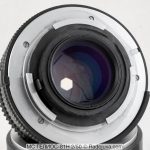
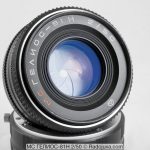
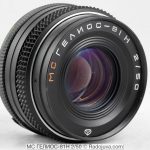
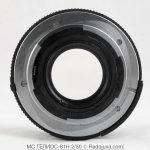
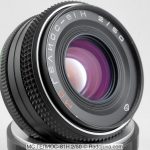
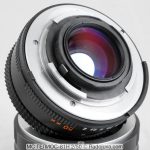
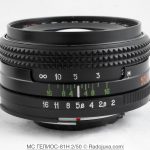
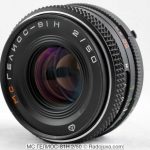
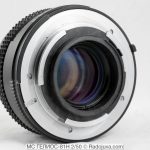
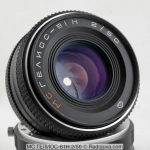
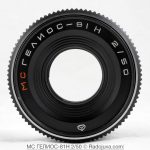
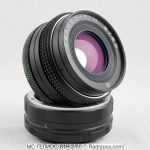
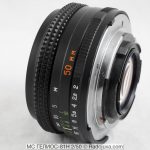
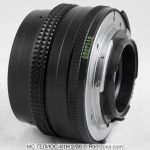
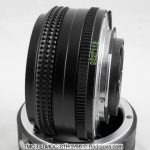
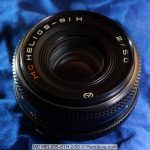
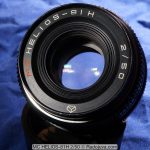
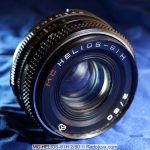

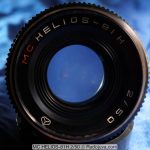
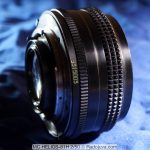
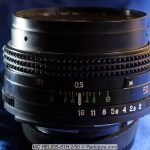
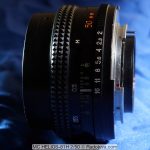
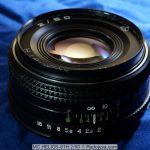
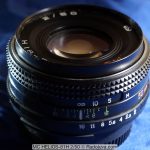
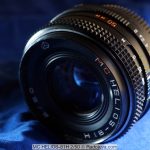
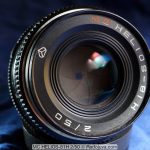
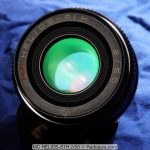
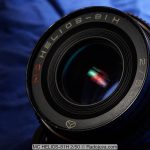
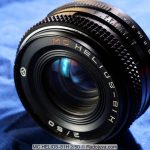
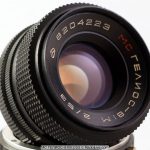
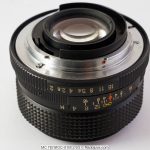
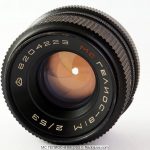
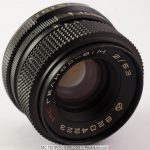
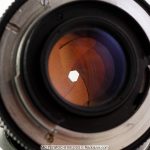
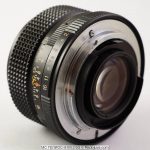
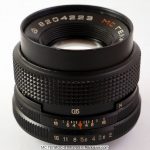
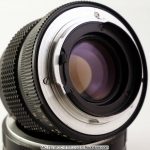
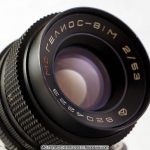
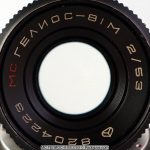
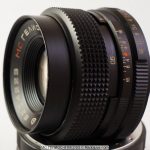
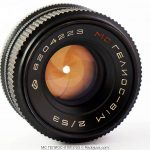
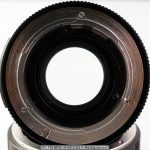
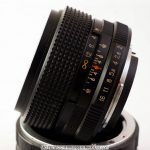
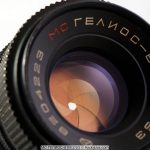
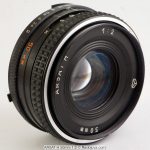
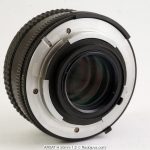
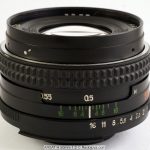
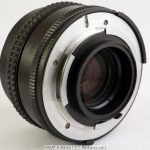
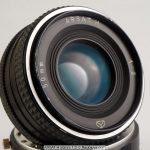
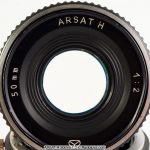
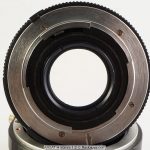
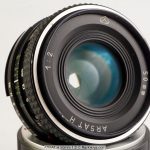
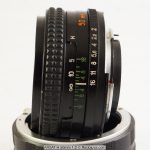

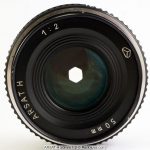
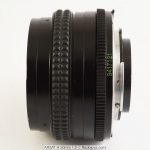
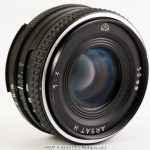
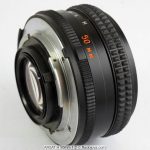
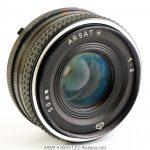
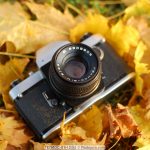
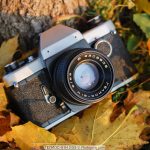
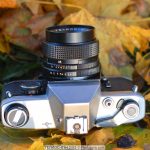
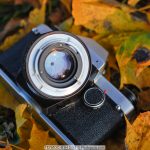
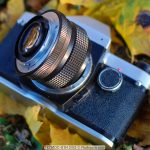
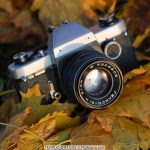
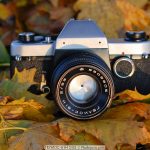
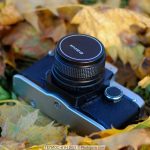
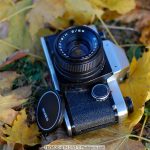
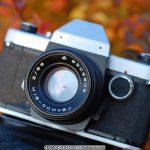
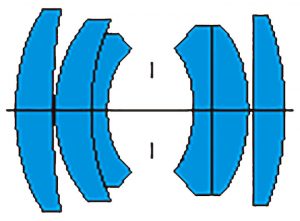
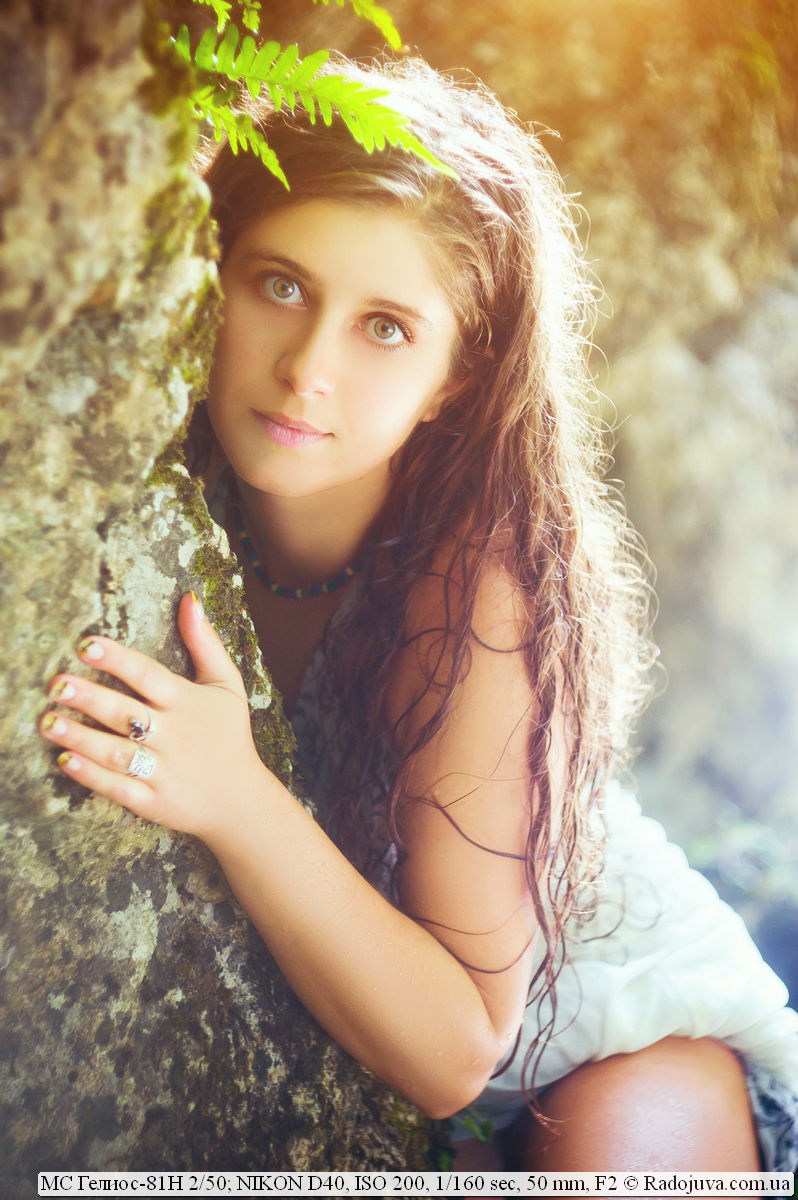
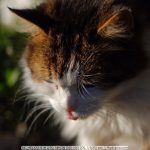







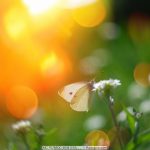

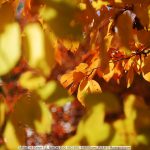
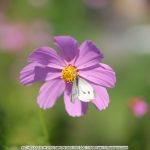
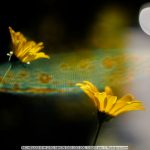


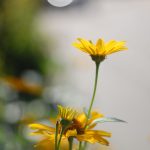



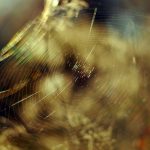
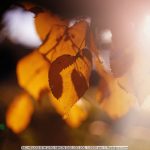

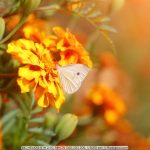



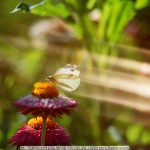

























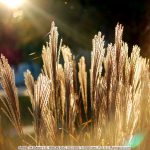



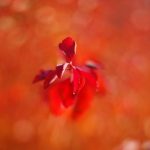


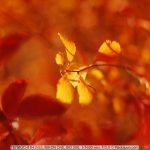
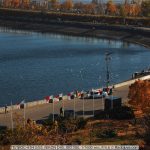

































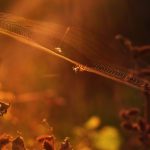
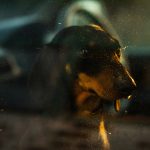










Thanks for the answer I began to click and enjoy))) Thank you so much!
I read a lot on your reviews site, and decided to buy a Soviet lens - Helios 81n. I have a large set of modern optics, but I wanted to try a rarity. and I have not regretted. this helios is a gorgeous lens. for those who are not confused by manual optics I recommend. of the shortcomings - it does not tolerate back and side light. everything else is super. my detailed review:
http://olegasphoto.com.ua/index.php/helios-81n-arsat-2-50/
Tell me, please, where can I get such a lens in Russia?
And how will it be on D 3200? I looked at the "HAMMER" - for some reason the prices are being turned down there!
on d3200 it plows normally. Purely subjective: the sharpness is better than on the 18-55 whale, but the loss in detail to the Nikkor is 35 afs, but not a fatal loss, let's say. Feature - in comparison with nikkors it gives a slightly “blurred” picture, less contrasting. Therefore, if I want a brighter picture, then I put the picture control on Vivid. Although, it is possible that this parameter depends on a particular instance.
I do not agree, whale 18-55vr sharper than Helios 81n
Yeah, you on a whale aperture 2.0 set and compare the sharpness
1. On the 18-55vr lens (ie, zoom), you do not physically set the aperture of 2,0.
2. What is the point of comparing zoom and fix? These are different things.
Something strange with me with the D7000 and Helios. M. mode. I open the aperture at 2, set the shutter to 1/8. The exposure meter at this time shows 0. I close the aperture completely, leave the shutter at 1/8, the exposure meter is naturally in full minus. BUT when shooting the image is the same as on the fully open aperture, which is impossible in principle. I came to the conclusion that the carcass simply takes a photo on the fully open aperture, regardless of where I twist the ring on the lens.
The diaphragm ring on the helios rests on the diaphragm lever, moves it where necessary, on the camera shows F From 0 to 6. I am not particularly expert in photography and concepts, but something is clearly wrong here. What can be wrong?
buy another camera
Jumping does not work.
I also had this, though with arsat-n and nikon d3100, but then somehow everything began to work. I came up with the idea that before installing it, I need to set the diaphragm levers to the highest or smallest value, I tried it and it helped me))
The way it is. Read the articles.
I also have a D7000 and Helios, the camera works perfectly with it (M, A modes). The main thing is to enter the lens data correctly.
Arthur, I have the same problem on the D7000. Can not do anything. I reread all the comments. And with pliers she was already trying to push the jump rope, as Arkady advised. Nothing. Did you manage to decide?
Tell me, please: (I immediately apologize for the links) Visually there is a difference between the two Helios 81H 2/50:
http://img20.slando.ua/images_slandocomua/137410455_7_644x461_kiev-19-s-obektivom-gelios-81n-ms-2-50-kofr-.jpg
http://img28.slando.ua/images_slandocomua/138041095_4_644x461_ms-gelios-81-n-elektronika_rev001.jpg
But what is the difference in them, except for the width of the serifs on the focal ring?
rіk vipusku?
Shaw itself turbuє ..?
Hello. Need some advice. I bought this lens and installed it on my Nikon D3200 without any problems. But I noticed that when the aperture changes in the photo, nothing changes, that is, from the F-2 aperture, switching to F-16 (in theory, the photo should sharpen and darken if you do not change the shutter speed or ISO), nothing happens. Then, having reduced the shutter speed to the value at which the “jump” of the aperture is clearly visible, I realized that the aperture does not close at any of its set value. After removing the lens from the carcass and trying to move the “tongues” or the aperture lever, I noticed that the aperture closes properly to the desired value, but does not swing back. There is a spring.
Tell me what it is and where to go with it? Or is it possible to make not a jumping aperture but completely manual?
Thank you in advance.
Master of intelligent treba. Smell, ob'єktivi for an hour to "be around". You can take a copy
I can tell you if you have not resolved the issue.
Stepan, please tell me! Nikon D7000. I bought MC Helios 81H lens 2 years ago from a reliable seller. Everything worked fine. I didn't shoot them for a little over a year, and here's the same picture - the aperture does not close when shooting. You can only shoot with a value of 2.0. Save, kind people!
I had a problem with the aperture on such a lens. It turned out that grease got on the diaphragm blades. Dismantled, rubbed, assembled, working!
Alexey, did you manage to solve the problem?
Tell me what is better to buy (excluding the price) Nikon 50mm F1.8G or Helios-81N I do not want to buy a Soviet lens so that it would lie around.
Helios will have to be completely rotated with the handles. Well, exposure metering and other convenient things on the "junior" cameras will not work .. So if such a dilemma arises, take afs nikon and shoot at your pleasure.
Hello, but tell me please! how is he with distortion (and does it exist)?
I just have helios-44m - there is no distortion on it at all, but I want to change it to 81 because of infinity. Wouldn't 81m / 81n be worse in distortion? (after all, they have a smaller focal point)
On crop it does not exist at all. On ff it is minimal and insignificant ..
Thank you
I am very grateful to the distinguished Author for his most useful work, which is simply difficult to overestimate! After reading the reviews, I rummaged “in the attic” and found Jupiter 37 and Helios 81 there, put them on Nikon d200 and now I get the long-forgotten pleasure of focusing on frosted glass and the need to “wiggle my legs and brains” when composing the frame. And the picture - just bursting with pride for Arsenal (well, for Zeiss a little). Regarding the picture from Helios, my copy does not just wash at a fully open aperture, but at a position between 2 and 2,8 it “draws” much better (subjectively expressed in an improvement in edge sharpness with wonderful bokeh). I am glad that the design allows for convenient use of intermediate values. At 5,6, we have a full set of remarkable characteristics: resolution, contrast, plasticity, and blur are acceptable. In a word, for your money - a masterpiece lens!
Good I have a Helios 81M 2/53 lens. 81 years of release. Please tell me whether it is worth changing it to Helios 81N MC?
If it suits you - why?
Hello! I'm completely confused in these Helios. The other day I bought on a hammer MC Helios 81-H 2/50, but it looks very strange. Externally, 1 in 1 is similar to Helios 81M from a neighboring review, except that it is written on the front of the Helios 81-H 2/50 MC and the serial number is in the same place (although it seems to be knocked out on the ring) and the thread diameter on the filter is 49mm .
I have the same.
just a few different cases, and that’s it.
Helios 81M (53) went with Olimpiysky cameras, often behind the cordon with tourists. That is why today's marketers have come up with a trick. The letter "M" in the name of the asset means associatively "Moscow"
Hello Arkady! Tell me please! I’m worrying about which lens to choose for a beginner with Nikon D3100, MS Kaleinar 5N or Helios 81N ?? It seems that Helios has a higher aperture but they say that the kaleinar is also good !! Generally confused ... Thanks in advance for the answer !!!
To begin with, it is better to get acquainted with a shorter-focus lens, in this case - with the G81N.
The filter thread at 81N is not 52mm but 50mm. :)
Thanks for the review!
I have two different 81N, in one thread under a 52mm filter (I bought and screwed it myself)), and in the other 52 mm it does not wind less.
there is no such M50 thread. Helios are with M49 and M52.
I absolutely agree.
Tell me if 81n will stand on the Nikon d7000 camera? So will he work with him?
Should sit down without any problems. Installation problems are mostly only with cameras that have a 'FEE' lever (details here https://radojuva.com.ua/2012/06/nikon-ai-s-old-lens-about/).
Good afternoon, Arkady.
Put the Arsat 81 n on the Nikon D7000.
At portrait distances, everything is super. Sharp, starting with f = 2. (although there is a small front focus, when focusing on the viewfinder, I make a small correction or I’m guiding it through live view)
But I tried to point to infinity (on an open hole), then the distance from 40-50 meters and then solid soap. On the horizon, objects are generally not in focus on the aperture from 2 to 4.
True, at 4-5,6 it becomes sharper, at 8 and 11 the horizon is finally very sharp. (significantly sharper than Nikkor 18-105 with a focal length of 50mm and at d = 8)
Tell me, is soap up to q = 5.6 a feature of my copy, or should it be so?
Thank you in advance.
At open apertures, when going beyond the “tabular” values of the focusing distances, i.e. to infinity, the sharpness of the lenses perceptibly falls. For helik it starts somewhere in 10m.
Squeezing the aperture increases sharpness, which is why landscape painters work with tripods and strongly closed apertures, compensating for this
You might consider shooting a landscape at the same 18-105 with a 3,5 aperture unrealistic. and do not say that only sharpness will be worse, sharpness is all right, just the close-up will be more blurry
And what kind of tabular focusing values are it if you have written an MDF of 0,45 m, then it goes without saying that to infinity or to the stars it is somehow specially guided?
Good day. Tell me, what is the difference between the export version of the lens and the one that was produced for the domestic market? And what is the dependence of the build quality and the presence of any factors (for example, multilayer or single-layer enlightenment) on the year of assembly thereof?
The presence of multilayer coating is indicated by the designation “MC”. They say that export is better, but in fact, the quality depends on each individual copy.
What do you need to get MS Helios-81H 2/50 to Nikon D3100?
Yes, it does. Install without adapter.
Arkady, maybe you have already answered this question? then excuse me ... - are the old Soviet light filters (such as ZhS-1,5, ZhZ, etc.) worse than the quality of new ones, like Japanese ones? And further. Which “eat” more incoming light - old ones? or the same?
d300s, helios was bought solely from the impressions received on this resource, I will join - the lens is very good, just for a photo hobby, not thoughtless clicking, I got on the camera without any problems, the only thing that I confused the diaphragm, the cat should be put in the menu of the device , putting 16 instead of 2.0 and Pts wondered why everything is through the ass :)
And in terms of prices, yes ... Avito does not even talk about 10-30 dollars, his ms and 92 years old are in good condition, though there is a bottle, I took it for three thousand and do not regret a drop, I bought him a fashionable cap, Arkady Thanks for your reviews.
Is this lens suitable for nikon d70s?
The photos in the review are gorgeous. As the people say: "You probably have a very good camera." :) I'm looking closely at this lens, thanks a lot for the review!
Thank you for the useful information. I received this lens as a gift, I will "test" it with the Nikon D300 camera
Tell me please. there is a D3100. Immediately after the whale I bought Jupiter 37a, I’ve already shot from it. so manual focus is not scary. Now there is a choice: nikkor 1.8 D AF or Helios 81n. for both asking 3000. which lens is better?
Colleagues, I will buy, but only from Kharkov !!! I went to Aukro, but somehow scary (I also go to the photo market - I'll ask the price ... but I'll take it for 650 ..
Thanks for the review, Arkady! A few months ago, with your, in fact, filing, inspired by the material, I bought this lens for the nikon d3200. I was not completely disappointed. Fine glass.